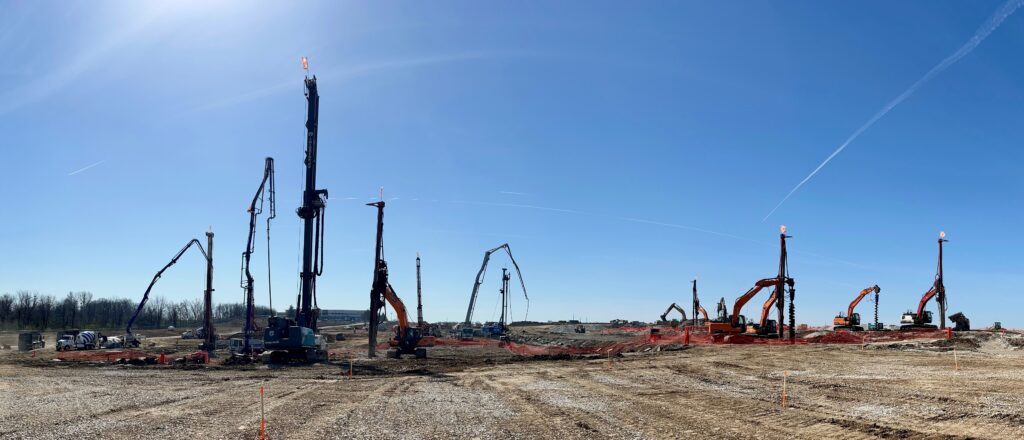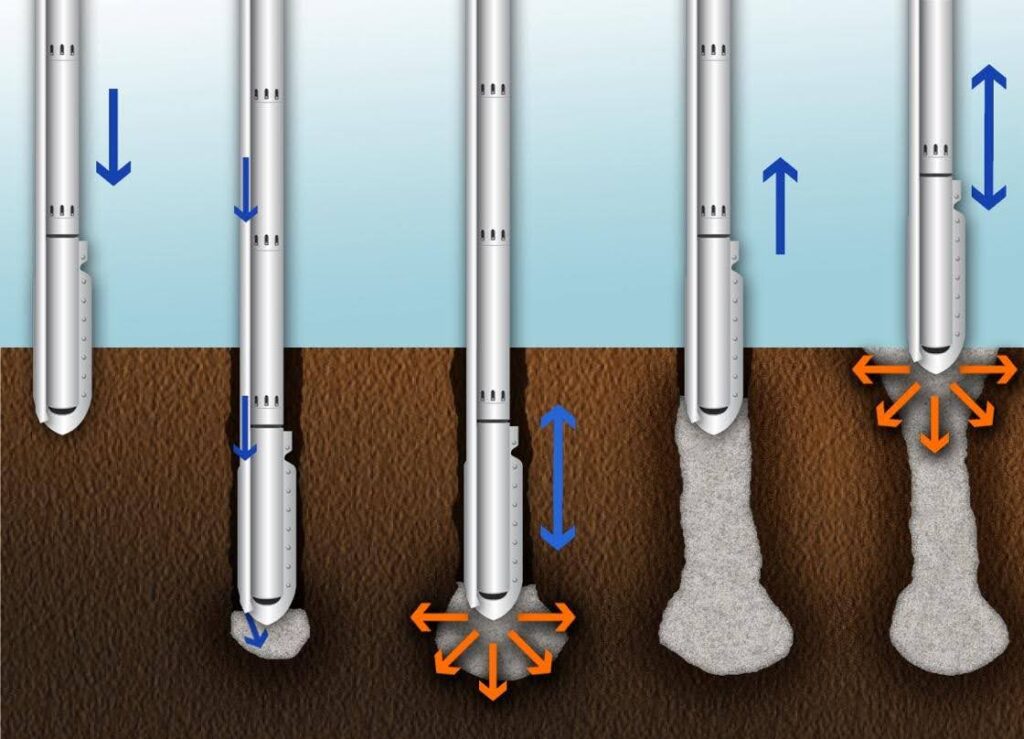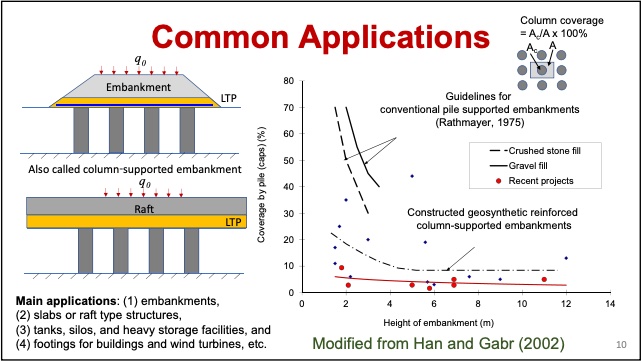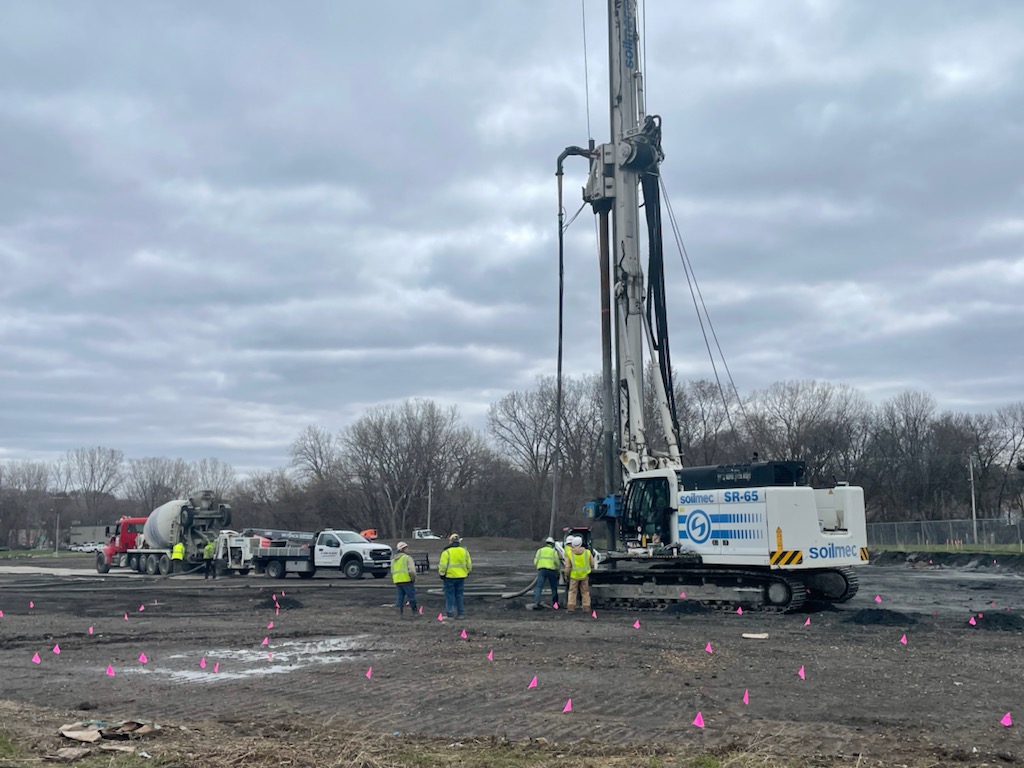What are Rigid Inclusions? | Types of Rigid Inclusions | Common Uses | Installation | Rigid Inclusions vs. Aggregate Piers | Rigid Inclusion FAQs
Rigid inclusions are unreinforced, grouted concrete columns installed in very soft soils to meet settlement criteria and improve bearing capacity for support of shallow foundations of a structure.
Specific soil characteristics dictate whether rigid inclusions or aggregate piers are a best-fit for cost-effective ground improvement that will meet bearing requirements and settlement criteria.

Subsurface Constructors installs rigid inclusions and aggregate piers to ground support large fills on site. Subsurface Constructors has designed and installed ground improvement for more than 1300 projects.
What are Rigid Inclusions?
Rigid inclusions are unreinforced, grouted concrete columns installed in very soft soils to meet settlement criteria and improve bearing capacity for support of shallow foundations of a structure. They are considered ground improvement because they are not structurally connected to the building they support, and are typically used when the soils are too soft and/or loads are too high for aggregate piers.

Rigid Inclusions / Vibro Concrete Columns (VCC) Load Transfer Platform
In addition to the grouted columns, an essential element of rigid inclusion ground improvement is the load transfer platform, or LTP. This is a layer of granular, structural fill that bridges the load between the rigid inclusions and prevents too much point stress on the footing.
This method of ground improvement is used for very weak soils, such as organic silt, peat, very soft clay or any soil where there is little to no lateral confinement from the surrounding soil. This is also indicated by weight-of-hammer (WOH) soils or soil with very low blow counts.
Types of Rigid Inclusions
The term “rigid inclusion” is a generic term for ground improvement with unreinforced, grouted columns, and there are different installation methods and names for rigid inclusions across geotechnical contractors.
- Rigid inclusions installed with vibrating probes to displace the soil are called vibro concrete columns (VCCs).
- Others are installed using a reverse flight rotating auger to displace the soil. These may be called Controlled Modulus Columns® (CMCs) or DeWaal piles®. (These are proprietary phrases trademarked by specific companies.)
- Rigid Inclusions are most often installed using a drilled displacement technique.
But the industry is generally moving toward the umbrella term “rigid inclusion,” making it the most straightforward way to describe this ground improvement technique.
Common Uses and Application for Rigid Inclusions
Geotechnical contractors use rigid inclusions for ground improvement on projects such as multi-story buildings, large tanks, earthen embankments and bridge approaches with mechanically stabilized earth walls.

Source: State of the Practice of Rigid Inclusions
Other common uses include:
- Increasing bearing pressure for spread footing support
- Mitigating settlement under large fills
- Usage when soils are too soft for aggregate piers
Installation of Rigid Inclusions
A geotechnical contractor will install rigid inclusions by laterally displacing the soil by either advancing a vibrating probe or by using a displacement auger. Typical depths using vibratory probes are on the order of 25 to 40 feet, while drilled auger methods can reach depths of 60 to 70 feet or even deeper. They can be installed at a rate of 30 to 40 columns per day, depending on their depth, and range in diameter from 12 to 18 inches. The columns will set within a day and cure to allow further construction in a week to 10 days, depending on the grout mix.

The LTP is installed on top of the rigid inclusion and is composed of a layer of granular, structural fill with varying thickness (from 6 inches to 3 feet), depending on how widely loaded the area is. Thicker LTPs may also be reinforced with one or more layers of geogrid or high-strength geotextile.
Finite element modeling (FEM) will sometimes play a role in rigid inclusion design — especially when an LTP is used, as the interaction between the grouted column and the LTP is quite complex. The geotechnical team may use FEM to design the columns to provide the desired bearing pressure and meet settlement criteria, or to optimize the number of columns installed on a site and provide maximum cost-efficiency.
Finally, scenarios exist in which rigid inclusions are designed in tandem with aggregate piers. This hybrid technique can be used where grouted columns are used in the zone or layer with the soft organic soils and then aggregate piers are used elsewhere. Another scenario for hybrid ground improvement would be to address different loading conditions across the site. For example, the columns of a multi-story building on soft soil may be supported by rigid inclusions to carry the higher load, while the floor slab (which isn’t as highly loaded) can be supported by aggregate piers. This can provide a more cost-effective solution than using rigid inclusions across the entire site.
Rigid Inclusions Installation Video
Subsurface Constructors installs rigid inclusions for a Kentucky water treatment plant.
Rigid Inclusions vs. Aggregate Piers
It’s important to note that the best ground improvement technique for a project ultimately depends on the soil data gathered on-site. All things held equal, aggregate piers are typically the cheaper of these ground improvement techniques, as stone is cheaper than concrete. Also, aggregate piers can usually be installed much faster than rigid inclusions.
But at the end of the day, a geotechnical contractor will recommend a solution that will ensure adequate bearing pressure and minimal settlement for the structure based on the analysis of the soil properties as described in the geotechnical soil report as well as the structure’s loading conditions. For sites with very soft soil, this often means rigid inclusions, while sites with soils that have bit more strength and ability to provide lateral confinement will be able to support the installation of aggregate piers.
An experienced geotechnical contractor will ensure your ground improvement is engineered in a safe and cost-effective manner. To begin a discussion with a geotechnical engineer about ground improvement options for your next project, reach out to us today.
Frequently Asked Questions
What is load testing of a rigid inclusion?
A load test on a rigid inclusion typically consists of a static test using the standard ASTM D1143 test method. Resistance (tension) elements are installed and a load frame is set-up, allowing for two times the design load to be applied to the pile. Settlement/displacement of the top of the pile is recorded verifying that the design load is met, typically with a factor of safety of 2.
What are the advantages of rigid inclusions?
The primary advantage of rigid inclusions is that it is a ground improvement technique that still allows for the structure to be supported on spread footings even though the soil profile is often quite soft or loose. Shallow spread footings are typically more cost-effective than having to support the building on deep foundations with pile caps/grade beams.
What is the capacity of rigid inclusion material?
The rigid inclusion material is grout with a 4,000 psi design compression strength. The capacity of the grouted elements varies based on their diameter. The typical load carrying capacity is up to 100 kip for a 12-inch diameter rigid inclusion and up to 150 kip for a 16-inch diameter rigid inclusion.
What are the different drilling tools used to create rigid inclusions?
There are different tools that can be used to install rigid inclusions, but the most prevalent installation technique is to use a displacement auger in the drilling process that laterally displaces the soil rather than remove it from the hole. Several companies have their own version of this tool but they are all fairly similar. Vibratory probes may also be used to install rigid inclusions and will radially displace the soil during tool advancement as it’s pushed into the ground.
Written by: Lyle Simonton, P.E. , LEED® AP
Lyle Simonton is the Director of Business Development for Subsurface Constructors of St. Louis, MO, with offices in Baltimore and Minneapolis. Lyle holds a BS in Geological Engineering from Missouri University of Science and Technology (formerly the University of Missouri-Rolla) and a MS degree in Civil (Geotechnical) Engineering from the University of Illinois – Champaign Urbana. He is a registered professional engineer in Missouri.
Lyle is a member of ASCE and DFI, and actively participates on the Soil/Ground Improvement Committees for both the ASCE Geo-Institute and the Deep Foundations Institute. He is a Past – President of the ASCE St. Louis Section and currently serves as its Membership Chairperson. Lyle has been an active member of the St. Louis GeoInstitute Chapter throughout his career. He is also a member of the Professional Advisory Board for the Civil and Environmental Engineering Department at Southern Illinois University at Carbondale, and is on the Board of Directors for the Southern Illinois Builders Association.


